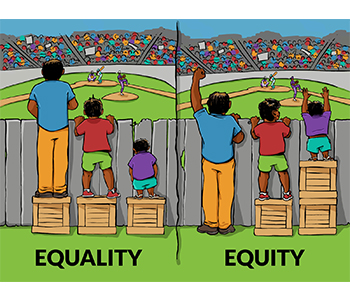Racial and ethnic equity: A necessary response to the changing demographics of the California Science classroom
By Dr. Nancy Nasr
Hello, I’m glad you’re here! Welcome to the first article of a series of articles devoted to the topic of equity in science education. This article series will tackle equity in the science classroom as it relates to the diversity of our students. While our students come from highly diverse races, ethnicities, gender identities, socioeconomic statuses and more, each of these diverse backgrounds requires significant unpacking. In this article, we will take a closer look at equity in the science classroom in the context of racial and ethnic diversity. So without further delay, let’s dive in!
So, what is equity? When we think about it, and try to define it we might think of words such as “fairness”, “justice”, and “impartiality.” Of course all of those terms play a significant role in our understanding of equity, however, it is important to note that equity cannot exist without also addressing diversity and inclusion. Diversity relates to the variation of students we see in our science classrooms, and inclusion relates to the need to ensure that all of our diverse students are included in the science learning community. Together, diversity, equity, and inclusion form a basis for science education that acknowledges the uniqueness of our students’ learning needs, backgrounds, and experiences, through classroom communities that ensure all students are provided with the tools and resources necessary for success in the science classroom.
Oftentimes, many people who are new to the concept of equity will confuse it with equality. Equality is not the same thing as equity, as equality assumes that all students are equal and require equal support to be successful. Equity on the other hand, acknowledges that all students are different and that the support required for these diverse students is variable from one student to another. The figure below summarizes the important difference between equality and equity, and is a good starting point for truly understanding this difference. It is unsurprising that diverse students will have different needs when it comes to being successful in the science classroom as these students come from a wide variety of races, ethnicities, gender identities, socioeconomic statuses, physical abilities, and more. It is this diversity of students that requires a commitment to equity, and it is a commitment to equity that ultimately reinforces inclusion.

So, why is equity so important in science education? Many California science educators will say that their student demographics are more diverse than ever before. Though student diversity includes differences in gender identity, socioeconomic status, and physical ability to name a few, diversity is also reflective in the wide array of racial and ethnic identities of our students. Many California educators report that the number of students from marginalized racial and ethnic backgrounds is quickly increasing and that the cultural makeup of their classrooms is rapidly changing. Changing racial and ethnic student demographics requires a collective cognizance of science educators to embrace cultural equity in their classrooms, to ensure that all students, from a wide variety of racial and ethnic backgrounds, are receiving access to high quality and relevant science instruction and learning experiences.
In addition to the changing racial and ethnic student demographic evident in California science classrooms, the current social climate also requires science educators to prioritize racial and ethnic equity in their classrooms. Science as a discipline is unique, as it can truly be used to explain the world around us, and thus, science instruction ought to be anchored within the context of larger society to be meaningful and relevant to students. With this in mind, science educators are challenged to develop instructional sequences that address contemporary civil issues such as the social construct of race, environmental injustices that plague marginalized communities, and the ways that science has historically been used to oppress marginalized groups. Doing so brings awareness to contemporary inequities that continue to plague our society and empowers students to use science as a means to overcome these inequities; which is of particular importance, if our students themselves are members of marginalized groups.
Now that we know fostering science classroom environments that prioritize equity is important, some of you may be wondering “where do I start?” The answer is simple, start small and work your way up. For example, the essential questions used to anchor lesson sequences can be modified and revised to prioritize equity. To illustrate, an essential question such as “how do living organisms alter Earth’s processes and structures?” can instead be modified to “how do the changes of Earth’s processes and structures affect marginalized communities?” Another example might include modifying the essential question “why do individuals of the same species vary in how they look, function, and behave?” to “why do individuals of the human species present with different races?” By reframing essential questions in the context of diversity, our science students can begin to understand how science can be used to explain social inequities, while also highlighting issues that are relevant and meaningful to our diverse students, thereby promoting racial and ethnic equity in the science classroom.
Another way to start infusing equity in the science classroom is to look at what is happening in the world around us. Recent events such as the Flint Water Crisis, the Chevron refinery explosion, and the disproportionate impact of COVID-19 on marginalized communities provide anchoring phenomena to explore issues of environmental racism and how science can be used to overcome these issues. Additionally, the recent resurgence of the Black Lives Matter Movement, and the birth of the #stopAsianhate movement can also provide anchoring phenomena that provide a framework for exploring the science of race, diversity, and scientific injustices that have served to reinforce marginalization and oppression. Addressing contemporary civil issues associated with racial and ethnic diversity provides our science students with a better understanding of the need for racial and ethnic equity and also fosters a classroom environment wherein discussions of race in the context of science is a welcome discourse, thereby honoring the unique experiences of a wide variety of racially and ethnically diverse students.
Equity in science education, and education in general, is a highly complex topic that requires significant deconstruction. With this in mind, I will continue to write articles for “The Equity Corner” that highlight other topics related to equity, both at the classroom-level and at the school-level. Future articles will be dedicated to discussions surrounding pedagogical strategies that promote equity in the science classroom, classroom management strategies that equitably honor the diversity of our students, and larger issues such as the negative impact of course tracking on equity. Additionally, future articles will address the importance of equity in the context of factors unrelated to race and ethnicity, but instead in the context of gender identity, socioeconomic status, physical ability, and more. Until next time!

Author Bio
Nancy Nasr is currently a California secondary school science educator with more than seven years of experience in the diverse classroom. Teaching a population of approximately 50% Latinx and Black students, Dr. Nasr’s continued research interest is anchored in cultural responsiveness in the science classroom as well as student attitudes toward culturally responsive pedagogy. Additionally, Dr. Nasr has an interest in exploring the ways in which the Science and Engineering Practices (SEPs) of the NGSS can be used to infuse science learning that is situated in phenomena associated with social justice, and empowering her students to overcome social injustices through the use of science. Dr. Nasr received her B.Sc. in Microbiology from University of Alberta. She received her M.A.Ed. in Curriculum and Instruction from California State University, Northridge and her Ed.D. in Curriculum and Instruction from University of South Carolina.




